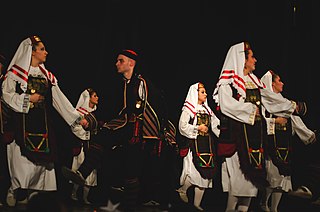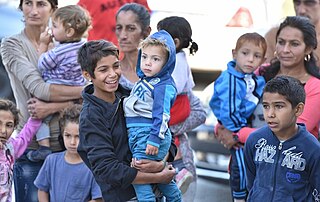Related Research Articles

Bosnia and Herzegovina, sometimes referred to simply as Bosnia, is a country in Southeast Europe on the Balkan Peninsula. It has had permanent settlement since the Neolithic Age. By the early historical period it was inhabited by Illyrians and Celts. Christianity arrived in the 1st century, and by the 4th century the area became part of the Western Roman Empire. Germanic tribes invaded soon after, followed by Slavs in the 6th century.

Jasenovac was a concentration and extermination camp established in the village of the same name by the authorities of the Independent State of Croatia (NDH) in occupied Yugoslavia during World War II. The concentration camp, one of the ten largest in Europe, was established and operated by the governing Ustaše regime, Europe's only Nazi collaborationist regime that operated its own extermination camps, for Serbs, Romani, Jews, and political dissidents. It quickly grew into the third largest concentration camp in Europe.

The Romani Holocaust or the Romani genocide—also known as the Porajmos, the Pharrajimos meaning the hard times, and the Samudaripen —was the planned effort by Nazi Germany and its World War II allies and collaborators to commit ethnic cleansing and eventually genocide against European Roma and Sinti peoples during the Holocaust era.
The Ustaše, also known by anglicised versions Ustasha or Ustashe, was a Croatian fascist and ultranationalist organization active, as one organization, between 1929 and 1945, formally known as the Ustaša – Croatian Revolutionary Movement. Its members committed regicide of the King of Yugoslavia, while later they also murdered hundreds of thousands of Serbs, Jews, Roma as well as Croatian political dissidents during World War II in Yugoslavia.

The Serbs of Bosnia and Herzegovina are one of the three constitutive nations of the country, predominantly residing in the political-territorial entity of Republika Srpska. They are frequently referred to as Bosnian Serbs in English, regardless of whether they are from Bosnia or Herzegovina.

The history of Jews in Bosnia and Herzegovina spans from the arrival of the first Bosnian Jews as a result of the Spanish Inquisition to the survival of the Bosnian Jews through the Holocaust and the Yugoslav Wars. Judaism and the Jewish community in Bosnia and Herzegovina has one of the oldest and most diverse histories in the former Yugoslav states, and is more than 500 years old, in terms of permanent settlement. Then a self-governing province of the Ottoman Empire, Bosnia was one of the few territories in Europe that welcomed Jews after their expulsion from Spain.

The Genocide of Serbs in the Independent State of Croatia was the systematic persecution of Serbs which was committed during World War II by the fascist Ustaše regime in the Nazi German puppet state known as the Independent State of Croatia between 1941 and 1945. It was carried out through executions in death camps, as well as through mass murder, ethnic cleansing, deportations, forced conversions, and war rape. This genocide was simultaneously carried out with the Holocaust in the NDH as well as the genocide of Roma, by combining Nazi racial policies with the ultimate goal of creating an ethnically pure Greater Croatia.

Gideon Greif is an Israeli historian who specializes in the history of the Holocaust, especially the history of the Auschwitz concentration camp and particularly the Sonderkommando in Auschwitz. He served as a visiting lecturer for Jewish and Israeli History at the Schusterman Center for Jewish Studies at the University of Texas at Austin during the academic year 2011–2012. He headed a commission that issued a controversial report in July 2021 that denied that the killing of Bosnian Muslims at and around Srebrenica in July 1995 constituted genocide.

The Holocaust in Ukraine took place in the Reichskommissariat Ukraine, the General Government, the Crimean General Government and some areas which were located to the East of Reichskommissariat Ukraine, in the Transnistria Governorate and Northern Bukovina and Carpathian Ruthenia during World War II. The listed areas are currently parts of Ukraine. Between 1941 and 1944, more than a million Jews living in the Soviet Union, almost all from Ukraine and Belarus, were murdered by Nazi Germany's "Final Solution" extermination policies and with the help of local Ukrainian collaborators. Most of them were killed in Ukraine because most pre-WWII Soviet Jews lived in the Pale of Settlement, of which Ukraine was the largest part. The major massacres against Jews mainly occurred during the first phase of the occupation, although they continued until the return of the Red Army of the Soviet Union.

The Xoraxane in Bosnia and Herzegovina are the largest of the 17 national minorities in the country, although—due to the stigma attached to the label—this is often not reflected in statistics and censuses.

The Holocaust in the Independent State of Croatia involved the genocide primarily of Jews, and also the genocide of Serbs and Romani (Porajmos), within the Independent State of Croatia, a fascist puppet state which existed during World War II, was led by the Ustaše regime, and ruled an occupied area of Yugoslavia which included most of the territory of modern-day Croatia, the whole of modern-day Bosnia and Herzegovina and the eastern part of Syrmia (Serbia). Of the 39,000 Jews who lived in the NDH in 1941, the United States Holocaust Memorial Museum states that more than 30,000 were murdered. Of these, 6,200 were shipped to Nazi Germany and the rest of them were murdered in the NDH, the vast majority in Ustaše-run concentration camps, such as Jasenovac. The Ustaše were the only quisling forces in Europe who operated their own extermination camps for the purpose of murdering Jews and members of other ethnic groups.
The double genocide theory is a conspiracy theory that alleges two genocides of equal severity occurred in Eastern Europe, that of the Holocaust against Jews perpetrated by the Nazis and a second alleged genocide that the Soviet Union committed against local populations in Eastern Europe. The theory first became popular in Post-Soviet Lithuania, in discussions about the Holocaust in Lithuania. A more explicitly antisemitic version of the theory accuses Jews of complicity in Soviet repression and characterizes local participation in the Holocaust as retaliation, especially in Lithuania, eastern Poland, and northern Romania.
Garavice was an extermination location established by the Independent State of Croatia (NDH) during World War II in Yugoslavia near Bihać, west Bosnia. Between 12,000 and 15,000 people, mostly Serb civilians, were murdered at Garavice by the Ustasha regime in 1941.

Bosnian genocide denial is the act of denying the occurrence of the systematic Bosnian genocide against the Bosniak Muslim population of Bosnia and Herzegovina, or asserting it did not occur in the manner or to the extent that has been established by the International Criminal Tribunal for the former Yugoslavia (ICTY) and the International Court of Justice (ICJ) through proceedings and judgments, and described by comprehensive scholarship.

The Chetniks, a Yugoslav Royalist and Serbian nationalist movement and guerrilla force, committed numerous war crimes during the Second World War, primarily directed against the non-Serb population of the Kingdom of Yugoslavia, mainly Muslims and Croats, and against Communist-led Yugoslav Partisans and their supporters. Most historians who have considered the question regard the Chetnik crimes against Muslims and Croats during this period as constituting genocide.
Balkan Jews refers to Jews who live or lived in the Balkans.

Genocide recognition politics are efforts to have a certain event (re)interpreted as a "genocide" or officially designated as such. Such efforts may occur regardless of whether the event meets the definition of genocide laid out in the 1948 Genocide Convention.
References
- ↑ Wawrzeniuk, Piotr (2018-07-03). ""Lwów Saved Us": Roma Survival in Lemberg 1941–44". Journal of Genocide Research. 20 (3): 327–350. doi: 10.1080/14623528.2018.1461181 . ISSN 1462-3528.
- ↑ Bartash, Volha (2017). "Family Memories of Roma as Sources for Holocaust Studies - Insights from the Belarusian-Lithuanian Border Region". S:I.M.O.N. Shoah: Intervention. Methods. Documentation. 4 (2): 4–17. ISSN 2408-9192.
- ↑ Tyaglyy, Mikhail (2009-03-01). "Were the "Chingené" Victims of the Holocaust? Nazi Policy toward the Crimean Roma, 1941–1944". Holocaust and Genocide Studies. 23 (1): 26–53. doi:10.1093/hgs/dcp015. ISSN 8756-6583. S2CID 143509247.
- ↑ "Bosnia and Herzegovina". RomArchive.